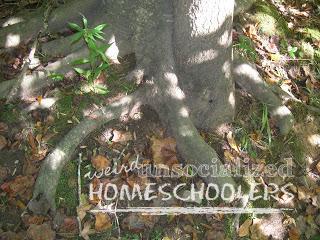Nature Study: Root Systems
We were able to get back to our nature center today after two weeks away. I’ve been thinking of making a new “you know you’re a homeschooler when” list. If I do, I’m going to have to include “when you miss two weeks at the nature center and are greeted with, ‘Hi, Stranger!’ when you go back.”
Yeah, seriously.
Our first stop this week was to check on our tree, a dawn redwood. We knew, from learning a bit about it before, that it has the unique distinction of being a deciduous conifer (it produces cones, but the leaves — or needles — change color and fall off), so we were curious to see how it had changed. When we first approached, we all thought that the leaves were withering. We were fascinated to discover, however, that they were simply going to seed:

I love when things like that even impress the kids. I got a much better picture of the whole tree this time, so that the shape is much easier to see:

It’s funny how we seem to find a common theme each time we go, though it’s never intended. This week, we seemed to focus on tree roots. We noticed a lot of roots on the trails and were discussing how there is at least as much of the tree underground as there is above ground. When we started really looking, we discovered all kinds of interesting root systems.





I was proud to get a decent picture of the sun creating a rainbow in a spider web, since I’m not usually able to get good spider web shots with my point and shoot camera.

The girls were fascinated to discover these leaves as big as their heads…they were huge!

We don’t know what they are yet, but we’re working on it. Speaking of which, I found this wonderful site for identifying trees by their leaves or their fruit. I wasn’t 100% successful, but it did, at least, point me in the right direction most of the time. We were able to identify some of the trees in our yard — a white oak, in additon to the Southern red oak, a Norway spruce and an Eastern red cedar. We’re still trying to figure out a couple of others.
Brianna and I were really impressed with how tall this tree appeared:

And, of course, what would a nature walk be without adding a mushroom photo to our collection. I thought this near-perfect mushroom was beautiful.

Another fun week outdoors for us, especially the the gorgeous sunshine and the perfect temperatures we had today. I love fall.
Kris Bales is a newly-retired homeschool mom and the quirky, Christ-following, painfully honest founder (and former owner) of Weird, Unsocialized Homeschoolers. She has a pretty serious addiction to sweet tea and Words with Friends. Kris and her husband of over 30 years are parents to three amazing homeschool grads. They share their home with three dogs, two cats, a ball python, a bearded dragon, and seven birds.



I had to chuckle over your comment about missing two weeks at the nature center and being missed. 🙂 We have that happen at the library all the time.
Anyway, great entry this week and I love how you are drilling down to so many great details not only about "your tree" but about trees in general with comparing roots. So much of what nature study is about is learning to observe changes and differences…that is how our brain works and it translates over into other aspects of learning in my experience.
Keep up the great work.:)
Barb
Love it, what a great idea to study the root systems. The leaves are amazing. That tree is beautiful. And I totally agree, we need to start a "Your know your a homeschooler when…" list haha!
I really need to do the nature walks. Wow! That looked like so much fun. Great Post.
I love the shot of the tree with the roots reaching down into the ground. Looks like the hand of a giant, fingers digging into the earth. Beautiful.